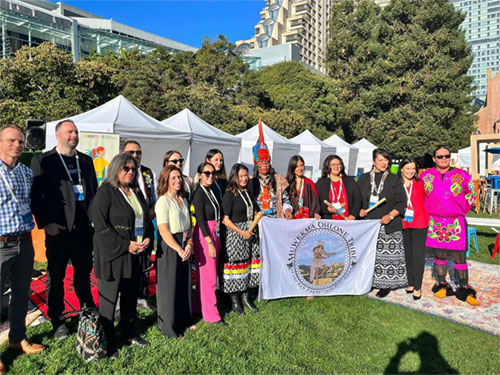The Native American Superpower
The Native American Superpower October 2023

Everyone knows that the original inhabitants were here on this continent for millennia before the European colonists arrived. The subsequent destruction of their society, culture and ways of life and the erasing of their histories is slowly being recognized today. Words and phrases such as “genocide,” “cultural subjugation,” “social emasculation,” and other defining terms are easily bandied about. They are all true to some (and often a great) extent. Today, there is enough known and accepted about the treatment of the Native Americans that any effort to whitewash or shrug-off what happened is a pointless exercise. Another matter that cannot be argued is that in the recent past, there has been a resurgence of Native American cultural revitalization, self-worth and tribal identity and citizenship.
Some social scientists argue about the reasons for this. Arguments range from guilt about the cruelty and subjugation of the Natives to a growing awareness of and repugnance for the social, moral and ethical biases of the past and present. While all these are to some extent true, the main reason for the resurgence of Native American self-awareness, tribal consciousness, and dignity and their increasing contributions to the growth of this country is the superpower of the indigenous people – resilience.
Resilience Is More Than Endurance
For over five centuries Native American people have survived efforts to erase them and their culture from the pages of history. The narrative of the growth and increasing power and influence of the U.S. has always been written by those who dominated the discourse. Like much of global history, that of the U.S. is full of false and biased narratives, teachings, and misinformation. The Native American population of North America before 1620 is not known, but some estimates put the number at close to 100 million, scattered across hundreds, if not thousands, of different tribes and nations Each of these self-sufficient nations endured massive physical destruction, psychological pain, dislocation, and genocide at the hands of Euro-American colonizers and their later descendants.
Despite the concerted efforts to erase Native American cultures, histories, religions and belief systems, and ways of life, the many surviving tribes continued to promulgate their existence. This was done through advocacy and the frustrating efforts to engage with state and federal governments that had no interest in their well-being. For every little success, there were major defeats. Case-in-point, in 1824, the Bureau of Indian Affairs was established to protect the interests of the indigenous people. Six years later, the Indian Removal Act of 1830 forced thousands of Native Americans living in the South out of their homes and caused massive loss of life, and huge cultural and social destruction. The ensuing years were full of broken treaties, theft of tribal lands and resources,racism, injustice, discriminatory laws and other efforts to if not erase the Tribes completely, then at least keep them subjugated and disenfranchised as domestic dependent nations.
The Tribes Came Back
Despite the efforts to destroy and absorb them into mainstream America as domestics and servants, the Tribes not only survived but began to grow, established their presence in the country and gained increasing influence over not just their affairs but even in those of the nation as a whole. This was done during and after organized Native resistance and warfare, or even as part of a civil disobedience movement. It was due to the resilience of the people. They withstood every possible obstacle and adverse governmental policy thrown at them and stood firm, suffered many defeats but came back stronger and interfaced with modern America without losing their culture, identity, and values.
Today, tribes like the Muwekma Ohlone stand proud of their heritage, history and contribution to the modern United States. It is not easy and there are many challenges in re-establishing the Muwekma Ohlone tribe as a Native American governmental entity. Go to the Tribe’s website to learn more about the actions underway and those being planned.
Please read: